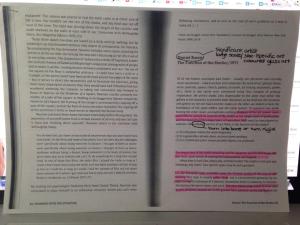
Daniel Buren (French conceptual artist and member of the Institutional Critique) delves into the relationship between the artwork, its place of fabrication; the studio, and its place of exhibition and widespread distribution; the gallery or museum. He begins by saying the studio always precedes the gallery, although the artist’s studio is often set up as though it were a tryout gallery (ie. white walls with artworks hung up). In this way, the gallery in a sense precedes the studio as the artist is already envisioning the result achieved in the final exhibition of the artwork.
The French conceptual artist draws from his personal life and more particularly his travels to form conclusions on the process of production of both French and American artists. He notes how the architectural construction of a typically Parisian studio is entirely different to the American studio type. Buren observes an undeniable link between the works of art and the studios they were produced in as well as the surrounding landscapes that helped spur their fabrication.
Buren states: “The alignment of works on museum walls gives the impression of a cemetery; whatever they say, wherever they came from, whatever their meanings may be, this is where they all arrive in the end, where they are lost. This loss is relative, however, compared to the total oblivion of the work that never emerges from the studio,” (p.85). This statement refers to the idea of sacrifice and having to make a choice for public acclaim – Is the artist willing to risk his integrity and the integrity of his work in order to gain popularity? Buren delves into the decreasing meaning of an artwork as it is subjected to its process of distribution. He believes that the artwork is most powerful and carries most meaning when in its place of origin; the studio. Buren also says that when found amongst a number of other artworks by the same artist, finished or unfinished, the audience will understand considerably more about the artwork at hand and its meaning. Once it is displaced and found in a gallery, away from its environment, it loses its meaning among other artworks it originally had no connection to. Surrounded by these diverging artworks and subsequent artists, the artwork takes on an entirely new meaning for an audience who will sadly never witness the artwork in its original context and splendor.
Buren describes curating as the process for making something public. The assumption that the artist will be a public agent can be made.
There were a few terms I felt compelled to research and these included:
Antagonistic: A person who actively opposes or is hostile to someone or something; an adversary
Estheticizing: Represent (something) as being beautiful or artistically pleasing
Esoteric: Intended for or likely to be understood by only a small number of people with a specialized knowledge of interest
Corrosive: To cause damage
Aesthetic of Reception: Initial response of the beauty; form, color, how it looks
Non-entity: Non-existent, unimportant person or thing

Daniel Buren
(25.03.1938-Present)
This reading was interesting considering our rapidly approaching end of the year degree show. It got me thinking about how my final piece would induce reflection for the audience and made me realize my artist statement would really help in conveying more about me and my artwork and limit the losses of meaning when transferring my work from the studio to the exhibition space.

